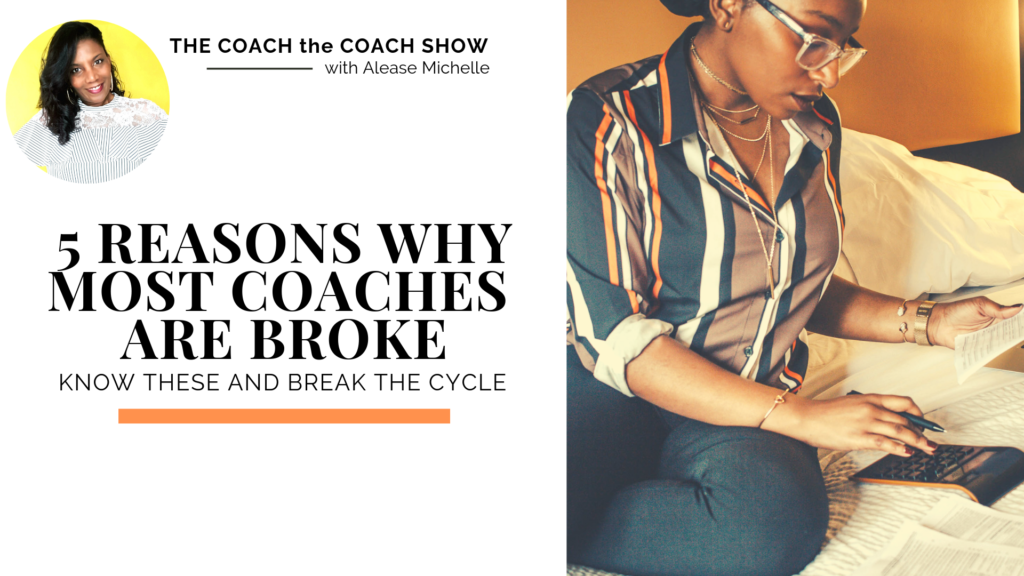There are five mistakes coaches frequently make that keeps them from really profiting. Learning about these common mistakes will set you ahead of other new coaches, but you won’t just learn what to avoid—you’ll understand what actions to take instead.
CLICK HERE TO WATCH VIDEO ON YOUTUBE
1. Chasing Clients instead of Creating Credibility
There are two ways to chase clients incorrectly: Number one is chasing clients when nobody knows you yet. Number two is continuing to chase clients after you’ve already landed a couple, instead of focusing on turning the ones you have landed into ecstatic fans and successful examples of what your coaching skills brought to their tables.
First, people have to want to be coached by you. In fact, you want them queuing up at your door. To achieve this, you need to create real credibility—for yourself, as well as for your potential clients.
If you feel like a fraud, your clients won’t have much confidence in you. In fact, you’ll have trouble landing clients, if you don’t feel ready.
Let’s run our own internal checklist. To be ready to coach, you need:
To understand clearly what coaching is—and isn’t
A common misconception is that coaches have to have “walked the walk” and become masters in the exact niche their clients want to master. Not true.
While it certainly helps if a coach is brilliant in a particular discipline or sport, what a coach really needs to be brilliant in is—coaching!
Mentors are the people who are many steps ahead of you in a niche. They can warn you of upcoming pitfalls, give you insider tips that will speed-boost your progress, show you how to complete a task and more.
Coaches are for people who have already developed the skills: They just need to know the best way to apply them and which steps will be best for their lives and/or businesses.
So a coach will help clients make decisions for themselves—and help them bring out skills, qualities and talents they didn’t know they had. Coaches boost confidence, and encourage critical thinking and sound self-analysis.
Proof
You’ll need proof that you’re the perfect coach for your ideal client. Once you thoroughly understand the coaching model and ideally have gained professional accreditation, your next step would ideally be to write a book.
If you go through mainstream publishing channels, this is not an effective strategy: You have to play Russian roulette, shopping your book query around to publishers plus even if it does finally get accepted by a publisher, you can count on at least a year or more likely two before you see it in print.
Fortunately, nowadays, it has become not only acceptable to self-publish digitally, but almost expected! So write a signature book and upload it to Amazon Kindle.
Your book can be on any topic you like, as long as it directly demonstrates what you have to offer your ideal reader.
Social Visibility
You don’t need to make social networking into a career, but social visibility is definitely a big plus—as long as you make it solid and consistent.
If you are a coach, you will want a page and a profile on LinkedIn. If you are a marketing coach and/or have written a book, one or more Facebook pages is a good strategy too. (Create a Facebook Page especially for your book or books!)
Instagram and Pinterest must-have accounts for any coach looking for more visability, with Pinterest having the benefit of acting more as a search engine than a social network. Be sure you’re using great search terms there for the best visibility.
Instagram continues to grow, and has captured the imaginations (and photos) of more than 28% of the American population. With a demographic that’s strongly skewed towards college-educated women in higher income brackets, it’s the perfect meeting place for coaches and the client who are searching for them.
But there’s one last ingredient to make sure you put into your basic credibility mix…
2. Only Offering One-on-One Coaching
“But anything else isn’t cost-effective”, you might say. After all, it’s well-known that financial success is based in a large part on charging more for less—and making a profit.
Any coach can tell you that one-on-one client coaching can be emotionally draining and incredibly demanding.
Plus you don’t want to spread yourself thin. Plus many clients just aren’t ready for that intensive a relationship: Or they don’t have the cash, or the time.
Your coaching needs to be scalable: Meaning you should be able to suit it to your client’s:
- Level
- Budget
- Learning preferences
- Communication preferences
- Degree of interaction needed
- Time constraints
Make sure you adapt your coaching to cover more than one model or delivery system—as many as fit comfortably with you and your clientele.
3. Not Adding Additional Streams of Income
One-on-one coaching limits your income in a unique way. No matter how high a fee you charge, you can realistically only coach a small number of clients.
Not only will adding additional streams of income increase your profits, it will also provide you with stimulating new experiences—and opportunities to expand your niche influencer status.
In addition to digital products such as Kindle eBooks or special reports, you can also try adding:
- Local events such as workshops and community college courses
- Speaking engagements
- Group coaching sessions
- “Packages” to enhance your coaching (e.g. templates or forms that would help your clients)
4. Not Having a Deep Funnel
Many people create a sales funnel: What they often don’t do is create a “deep” one.
The premise of deep sales funnels is simple:
- Start with your most inexpensive base product
- End with your most exclusive, high-end product.
What this means is: If you don’t have two-figure products and four or even five-figure products, your sales funnel can’t be considered “deep”.
- A perfect example of an inexpensive base product could be a $7 short video course
- Your most exclusive, high-end product could be a week-long, exclusive coaching retreat in an exotic location for $2,500
5. Not Investing in Yourself
The final mistake that leaves most coaches broke: Not investing in themselves!
Show me a coach who doesn’t have a coach and you’ll be introducing me to a coach who is not reach his or her full potential!
Think of coaching sessions—individual or in clusters of sessions—as vital and necessary “check-ins”. Talk to a top-level coach, and he or she will happily admit to having their own coach—often more than one. (For example, an investment coach, a lifestyle coach, a health-and-fitness coach, an executive strategy coach.)

